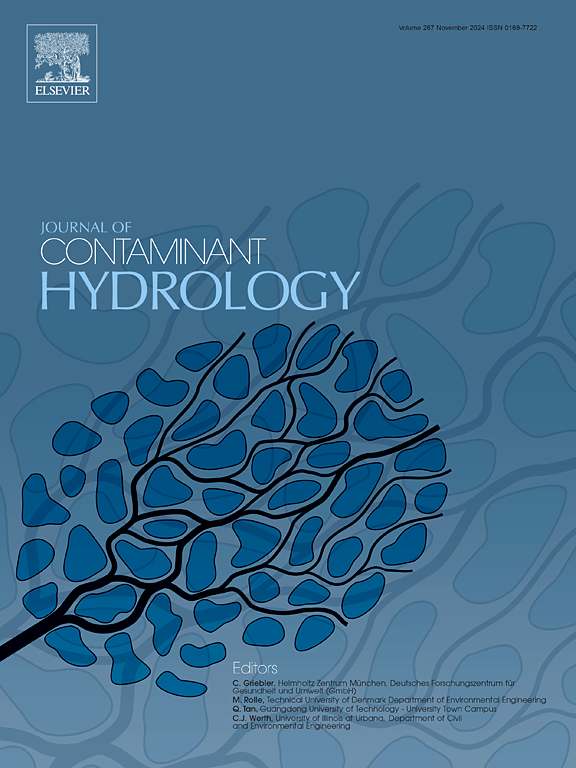模拟多种稳态地下水污染情景的解析元法解
IF 4.4
3区 环境科学与生态学
Q2 ENVIRONMENTAL SCIENCES
引用次数: 0
摘要
提出了一种新的二维反应输运问题的解析元法(AEM)模型。AEM方法由于多个边界条件的叠加而提供了域复杂性,同时最小化了计算量,是一种无网格方法。对于溶液的开发,应用平流-分散-反应(ADR)方程的变换,得到一个由修正亥姆霍兹方程控制的等效数学问题。循环源元的解(Mathieu函数的无穷级数)提供了在均匀流动中进行瞬时和二元反应的两种化合物的稳态浓度分布。沿边界条件的绝对误差为10−7 mg/l,相对误差为10−4。敏感度分析表明,源强度和反应物的利用系数是对烟羽长度影响最大的参数。利用不同的概念场景说明了所开发的AEM模型的实用性,其中多个源元素被叠加为协同和反向相互作用源。此外,采用图像的方法,使用相同的解决方案来表示垂直方向的域。这些突出了所开发模型在模拟各种实际条件方面的潜力,例如具有或不具有连续性的不规则源几何形状,具有不受限制的域范围和最小的计算工作量。此外,对三个现场进行了简要评价,以说明模型的适用性。本文章由计算机程序翻译,如有差异,请以英文原文为准。
An Analytic Element Method solution for simulating multiple steady-state groundwater contamination scenarios
This paper presents a new Analytic Element Method (AEM) model for a 2D reactive transport problem. The AEM approach offers domain complexity due to superposition of multiple boundary conditions, while minimizing computational efforts, being a grid-free method. For the solution development, transformations of the advection–dispersion–reaction (ADR) equation are applied resulting in an equivalent mathematical problem governed by the modified Helmholtz equation. A solution (infinite series of Mathieu functions) derived for circular source elements provides the steady-state concentration distribution of two compounds undergoing an instantaneous and binary reaction in uniform flow. The solution is verified with an absolute error of the order mg/l and a relative error of order along boundary conditions. A sensitivity analysis identifies source strength and utilization factor of the reactants as parameters with the strongest impact on the plume length. The practicality of the developed AEM model is illustrated using different conceptual scenarios in which multiple source elements are superimposed as co- and counter interacting sources. Additionally, the method of images is applied using the same solution for representing the vertically oriented domain. These highlight the potential of the developed model for simulating a variety of practical conditions, such as irregular source geometries with or without continuity with unrestricted domain extent and minimal computational effort. Further, three field sites are briefly evaluated to present the applicability of the model.
求助全文
通过发布文献求助,成功后即可免费获取论文全文。
去求助
来源期刊

Journal of contaminant hydrology
环境科学-地球科学综合
CiteScore
6.80
自引率
2.80%
发文量
129
审稿时长
68 days
期刊介绍:
The Journal of Contaminant Hydrology is an international journal publishing scientific articles pertaining to the contamination of subsurface water resources. Emphasis is placed on investigations of the physical, chemical, and biological processes influencing the behavior and fate of organic and inorganic contaminants in the unsaturated (vadose) and saturated (groundwater) zones, as well as at groundwater-surface water interfaces. The ecological impacts of contaminants transported both from and to aquifers are of interest. Articles on contamination of surface water only, without a link to groundwater, are out of the scope. Broad latitude is allowed in identifying contaminants of interest, and include legacy and emerging pollutants, nutrients, nanoparticles, pathogenic microorganisms (e.g., bacteria, viruses, protozoa), microplastics, and various constituents associated with energy production (e.g., methane, carbon dioxide, hydrogen sulfide).
The journal''s scope embraces a wide range of topics including: experimental investigations of contaminant sorption, diffusion, transformation, volatilization and transport in the surface and subsurface; characterization of soil and aquifer properties only as they influence contaminant behavior; development and testing of mathematical models of contaminant behaviour; innovative techniques for restoration of contaminated sites; development of new tools or techniques for monitoring the extent of soil and groundwater contamination; transformation of contaminants in the hyporheic zone; effects of contaminants traversing the hyporheic zone on surface water and groundwater ecosystems; subsurface carbon sequestration and/or turnover; and migration of fluids associated with energy production into groundwater.
 求助内容:
求助内容: 应助结果提醒方式:
应助结果提醒方式:


